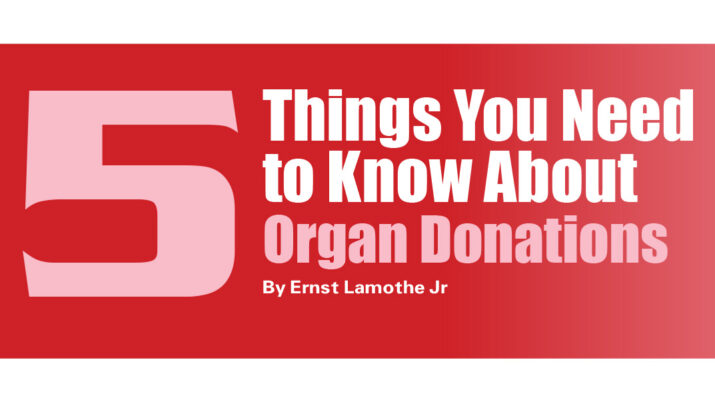By Ernst Lamothe Jr

for the Finger Lakes Donor Recovery Network, which covers a 20-county area in Upstate New York.
Every day, individuals worldwide wait for organ transplants that could mean the difference between life and death.
Despite advancements in medical technology, the demand for organs far outweighs the supply, highlighting the critical importance. In 2023, 46,632 organ transplants were performed in the U.S., which is an 8.7% increase from 2022 and a 12.7% increase from 2021, according to the Centers for Disease Control and Prevention.
“Without organ donors, hope would be lost,” said Nancy J. Ryan, director of development for the Finger Lakes Donor Recovery Network. “In this region alone, more than 850 adults and children are in need of a new organ to save their lives. Some patients wait years for their transplant and sadly, 16 people die each day because the donor organ they needed didn’t become available in time.”
Last year President Joe Biden signed into law the U.S. Organ Procurement and Transplantation Network Act. This law allows competitive bidding for federal contracts under the Organ Procurement and Transplantation network and expands the pool of entities that can contract with the organ procurement network. It modernizes the system to further protect and expedite the organ transplantation process. Since 1987, the United Network for Organ Sharing has been the only entity to manage the OPTN through a contract with the Health Resources and Services Administration.
Ryan mentioned five essentials of information about organ donation.
1 — You need to enroll as a donor
Hospitals are required by law to notify their federal designated organ procurement organization (OPO) — like Finger Lakes Donor Recovery Network — when a patient’s death is imminent, as well as notify their contracted eye and tissue recovery agencies when a patient dies at the hospital. The process generally involves first registering, which includes signing up as an organ donor through official organ donor registries or indicating your choice on your driver’s license. Next, informing your family and friends about your decision to ensure they understand and support your choice.
“The challenge is that people either don’t take the action to actually sign up as a donor or they avoid the decision altogether,” said Ryan. “It’s essential to take just a few minutes now to register as a donor because it helps to ensure your decision to help others is followed. It’s important to know that if you pass away and you had not previously registered or shared with your family that you wanted to be a donor, they would be left with having to decide about donation on your behalf. Imagine how difficult that may be for them. Families are often too emotional and unsure about what their loved one would have wanted, so they say ‘no’ to donation.”
2 — One donor can save the lives of eight people
Specific organs and tissues that can be donated include the heart, kidneys, liver, lungs, pancreas, intestines, corneas, skin, bone and more. Living donors can contribute organs such as a kidney or a portion of their liver. While age and health status are considered, there is no strict age limit for organ donation. Even individuals with certain medical conditions can donate specific organs or tissues. The decision to donate is typically based on medical suitability at the time of death.
“Individuals who wish to join the donor registry or are already in the registry, can specify the organs and tissues they want to donate to save and help others,” said Ryan. “One donor can save the lives of up to eight others. The heart, kidneys, liver, pancreas, lungs and intestines can all be donated to give second chances in life to others. Last year, nearly 40,000 men, women and children received life-saving transplants from deceased donor heroes. What is less commonly known is that one tissue donor could help up to 75 people through the donation of tendons, ligaments, veins, heart valves, skin and bone.”
3 — Number of donors in Upstate New York slightly higher than the national average
Finger Lakes Donor Recovery Network has worked to increase the number of registered donors in the 20 counties it serves. Its regional percentage of registered donors is 66%, which is higher than the national average of 65% and well above the overall 49% enrollment rate in New York state. Less than 10 years ago only 29% of the population in this area were in the donor registry.
“The increase in registered donors undoubtedly has helped save more lives. In 2023, nearly half of the organ donors from this region were registered donors,” said Ryan. “The US organ donation and transplantation system remains the best in the world and donation rates have increased for the past 13 consecutive years.”
4 — You can be old and sick — and still be a donor
For decades, medical professionals navigated through false public perception that doctors and nurses won’t work as hard to save your life if they know you are an organ donor. Organ donation is only considered after all efforts to save a patient’s life have failed.
“The most common misconception about organ donation is that people think they are too old or not healthy enough to be an organ donor,” said Ryan. “The fact is, organs have been donated and transplanted from donors who were in their 80s and 90s. Medical conditions like hypertension and diabetes also do not necessarily rule out donation. It’s important to know that there are no restrictions to signing up to be an organ donor, other than the enrollee must be at least 16 years of age in New York state. At the time of death — not at the time of donor registration — determinations are made about what organs can be donated to help others.”
5 — Ripple effect
Organ donation has a ripple effect that extends beyond the individual recipient. Families and loved ones of transplant recipients are given the gift of more time with their cherished family member, friend or colleague. The impact of organ donation goes beyond the physical act itself, fostering a sense of community. In 2023, more than 16,000 individuals became deceased donors, making 39,679 deceased donor transplants possible, which was nearly a 9% increase from 2022.

